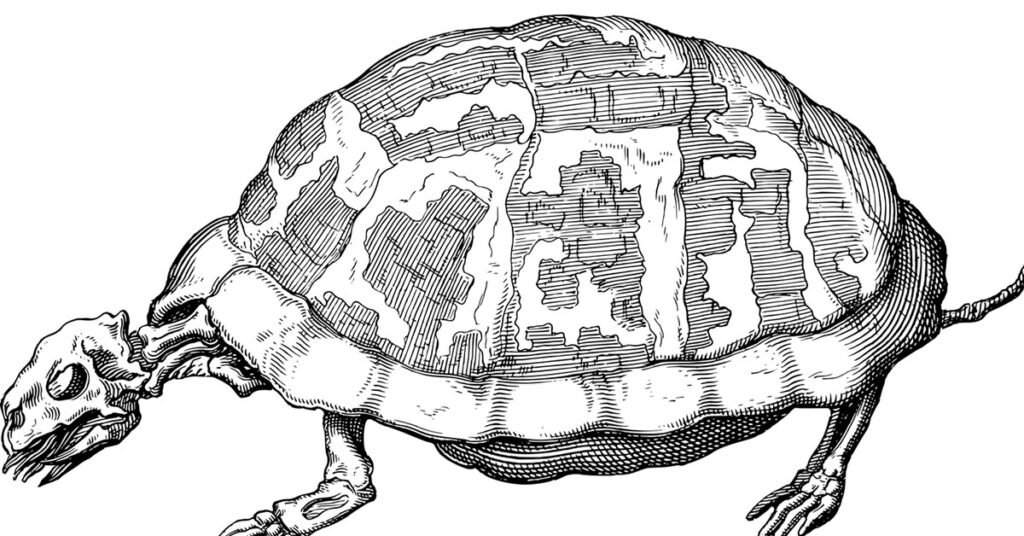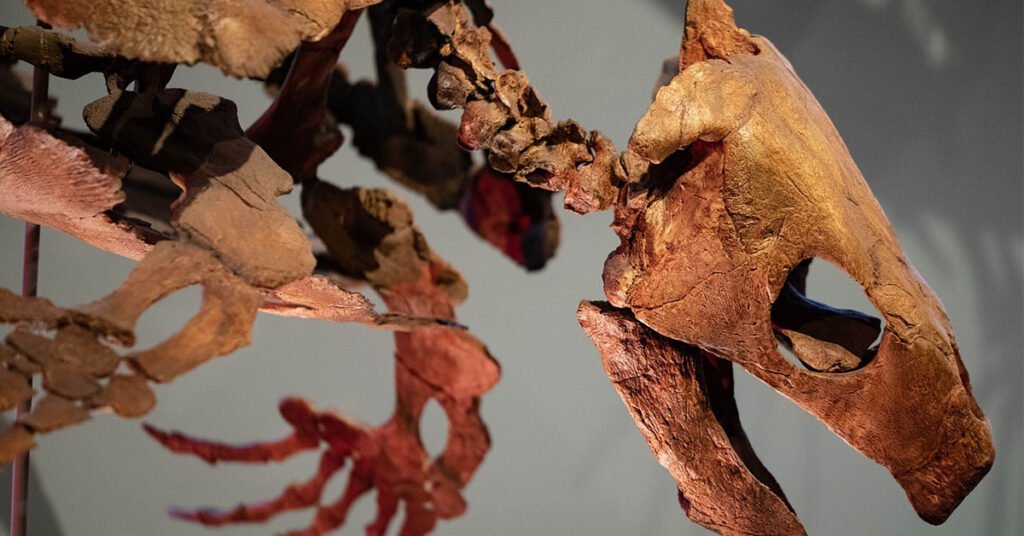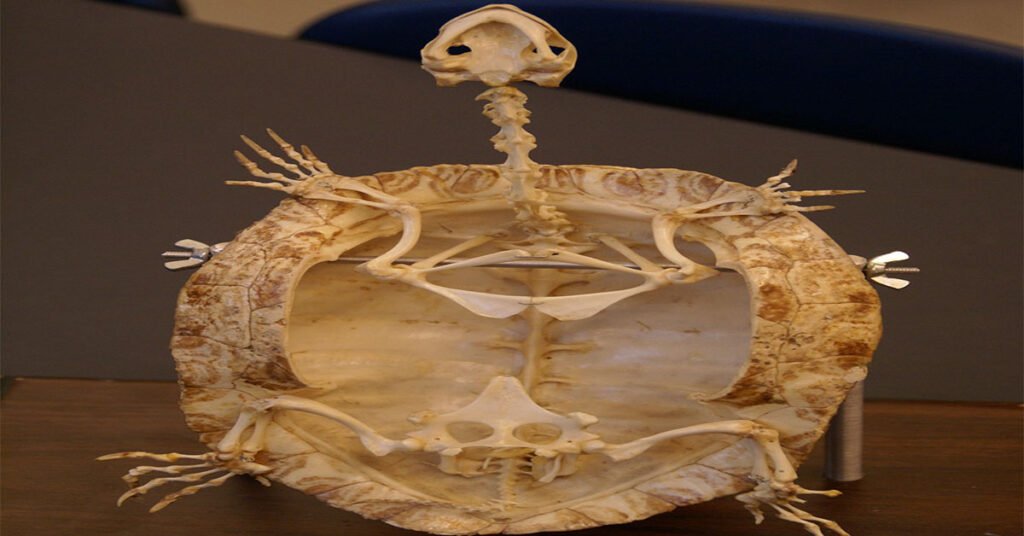Turtles are fascinating creatures with unique bodies. When we talk about turtle anatomy, we’re exploring how these animals are put together. But did the question ever come to your mind, “Does a turtle have an exoskeleton?” While animals like insects, spiders, and crustaceans boast exoskeletons for protection, turtles have different anatomical features. Turtles have shells that cover their bodies, protecting them like armor.
Their bodies are made up of bones, muscles, and organs, just like ours. But what makes them stand out is their shell, which is part of their skeleton and provides both protection and support. In this article, we will find out the answer to the question” Does a turtle have an exoskeleton?” and if not, how is their skeleton structure made? The anatomy of turtles helps us understand how they function and survive in their environment.
Table of Contents
Does A Turtle Have An Exoskeleton?

Turtles have an endoskeleton, not an exoskeleton like insects or crabs. So, the simple answer to this question,” Does a turtle have an exoskeleton?” is that turtles or tortoises do not have an exoskeleton. Their skeleton is inside their body, providing support and protection.
The turtle’s shell, made of bone and keratin, is part of its endoskeleton, not external armor. As a turtle’s shell is part of its endoskeleton, its function mainly focuses on their inside protection, not the outside for defense. This structural framework plays a crucial role in the turtle’s survival, giving it the ability to adapt and navigate.
What Is an Exoskeleton?
An exoskeleton is an external skeleton that provides support, protection, and structure to various invertebrate animals such as insects, crustaceans, and arachnids. The structure acts as a rigid framework for an organism’s body. This framework allows protection from predators, supports muscles, and attaches muscles.
As the animal grows, it periodically sheds its exoskeleton in a process called molting. It creates room for the formation of a new, larger exoskeleton underneath. As the organism grows, it can accommodate its growing size.
Are the Endoskeleton & Exoskeleton Different?

Yes, the endoskeleton and exoskeleton are different.
An endoskeleton is an internal skeleton found within the body of an organism, providing support, structure, and protection to internal organs. Vertebrates, including humans and turtles, have endoskeletons composed of bones and cartilage.
On the other hand, an exoskeleton is an external skeleton covering the outside of an organism’s body, as we mentioned earlier. It serves as armor, protecting the organism from physical harm and providing structural support. Arthropods like insects, spiders, and crustaceans have exoskeletons made of chitin, a tough, rigid substance.
Understanding Turtle Shells & Its Evolution
Turtles have a unique skeletal structure that forms their iconic shell. Contrary to popular belief, this shell is not an exoskeleton but rather an extension of its endoskeleton.
Evolutionary Origins
When a turtle is growing inside its egg, its bones start to form. At one point, its rib cage moves to the outside of its body, unlike most animals where it stays inside. This change is significant because it helps the turtle’s shell to grow the right way.
Shell Composition
The turtle’s hard shell is made up of bones like ribs, vertebrae, and parts of the shoulders and hips. These bones join together to form the top shell (carapace) and the bottom shell (plastron).
Shell Structure
The top part of the turtle’s shell, called the carapace, is made of bony plates called costal and neural plates. These plates come from inside the turtle’s body, showing that the shell is part of its internal skeleton.
Skin Covering
Although the shell seems like it’s covered in skin, it’s actually part of the turtle’s skeleton. The skin on the shell forms scales made of keratin, like our fingernails, giving extra protection.
Embryonic Development
During embryo development, which is when a baby turtle is growing inside its egg, something special happens. The rib cage moves outside the shoulders, which is essential for making the turtle’s shell.
Adaptations
The turtle shell is super special because it’s been shaped over millions of years of evolution. It’s like a strong shield that helps turtles live happily on land and in water, keeping them safe and cozy in all kinds of places.
Ongoing Evolution
Adaptations for survival in various ecosystems continue to shape turtle anatomy. Despite their seemingly unusual features, turtles demonstrate life’s remarkable diversity. After 100 years or more, if researchers look at turtles’ adaptation, they will find something different from today’s example.
Types of Animal Skeletons

Animals have different skeletons, which provide support and protection. One type is the endoskeleton, found inside the body like in humans. There are three types of skeletons in animals:
Endoskeletons
Endoskeletons are internal skeletons made of bones or cartilage. They offer structural support and protect internal organs. Humans, turtles, dogs, and birds have endoskeletons.
Exoskeletons
Exoskeletons are external skeletons made of hard, rigid materials like chitin. Insects, crabs, and spiders have exoskeletons which protect their bodies.
Hydrostatic Skeletons
Hydrostatic skeletons are found in soft-bodied animals like worms and jellyfish. These skeletons use fluid pressure to maintain body shape and movement.
Insects: Insects, such as beetles and ants, have exoskeletons that provide protection and support. Their exoskeletons are made of chitin, a tough material.
Humans: Humans have an endoskeleton consisting of bones and cartilage. Our endoskeleton provides support, protects organs, and allows movement.
Earthworms: Earthworms have hydrostatic skeletons, relying on fluid-filled body cavities for support. It allows them to burrow through the soil efficiently.
Crabs: Crabs have exoskeletons composed of chitin, which covers their bodies like a protective shell. Their exoskeletons defend against predators.
Different animals have different skeletons suited to their lifestyles and environments. Understanding these variations helps us to know their life’s variety.
Turtle and Tortoise Sensitivity: Do They Feel On Top of The Shell
Turtles and tortoises can sense touch through their shells, helping them detect warmth and potential threats. They also enjoy positive sensations, like being scratched or cleaned, like humans. Additionally, their ability to feel touch alerts them to potential threats, allowing them to react defensively to predators.
If a Turtle’s or Tortoise’s Shell is Removed, What Happens?
They can die without their shells, emphasizing their crucial role in their survival. Turtles and tortoises rely on their shells for protection, as it’s not just a covering but part of their skeleton. Tortoises, in particular, keep their shells throughout their lives, which helps them navigate and stay safe from predators. Handling them requires extreme care to prevent harm.
Read More: Does Box Turtles Like Water?
Conclusion
In conclusion, turtles do not have an exoskeleton. Their unique shell, formed from their internal skeleton, serves as both protection and support. Knowing the difference between an endoskeleton and an exoskeleton helps us understand their anatomy. So, to answer the question, “Does a Turtle Have an Exoskeleton?”-the answer is a resounding no!
